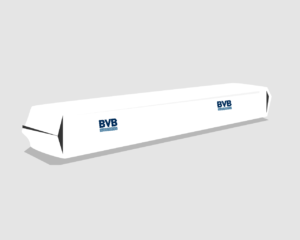In this article we look at different methods for growing strawberries in growing media. First we take a look at the pros and cons of different types of containers. This article also covers some information about watering and fertigation methods for strawberry growing.
Strawberry containers for growing media
First of all we’d like to emphasize the importance of having a good, free draining system. This is good for strawberry plants in all types of containers. In general we can divide the containers for strawberry growing media in three categories: grow bags, containers/pots and direct systems.
Growing strawberries in direct systems
Let’s start with a little more information about the last category; the direct systems. In these systems the substrate is spread directly over the gutters without any other container around it. Plants are planted directly into the substrate. In some direct systems the drainage channels tend to be very narrow. As a result they easily get clogged, which can cause direct contact between the roots and the run off water. This can damage roots or even cause them to rot.
In addition, direct systems need to be filled manually or with the use of special machinery. They also do not offer any flexibility for you production schedule, because plants can’t be controlled by cooling them down properly. The direct systems aren’t suitable for plants that need to spend the winter at minimal temperatures.
Growing strawberries in pots
Containers and pots have an open surface, which is an advantage directly after planting. The open surface enables the plants to benefit from the good microclimate at the initial growing phase. However, in later stages of the cultivation it can proof less fortunate when humidity gets too high or berries somehow lay on the surface of the growing medium, causing rot. You can prevent this by making sure to use containers with rather narrow openings on the top (less than 7 inches). To ensure a consistent filling volume in all containers you should take care of the filling mechanically.
Growing strawberries in grow bags
Grow bags are ready filled and drainage- and planting holes are perforated in advance, on demand. They do not have the issues an open surface can cause. They are somewhat wider (8-10 inches) and provide the plant roots with a little more space. Grow bags are generally a bit more expensive than the other two options. They also create more (plastic) waste as the bags themselves need to be cut open after use.
We would generally advise to use a system with higher connected volumes. The reason for that is that 10 plants in 20 liters of growing medium usually perform better than a single plant in 2 liters would. In a bigger connected volume the plant roots get more space to grow and the moisture and nutrient availability are more constant.

Irrigation methods for growing strawberries in growing media
The frequency and amount of irrigation needed depends on a complex set of parameters. Here’s a list of some of the things you need to take into account when creating your irrigation strategy:
- Quality of growing medium
- Volume of growing medium per plant
- Plant size
- Growing stage
- Temperature
- Humidity
- Radiation
Our Sales Advisers are specialized in this type of challenges and can think along to determine the best strategy for you company.
Fertigation
As described in our article Conditions for successful strawberry cultivation, water quality is crucial for successful strawberry cultivation. Water quality also has a big influence on determining the optimal fertilizer composition for your plants. All elements that are present in your irrigation water, as well as EC and pH levels need to be taken into account.
If the EC level of the fresh water is a lot higher than the required level for irrigation, the influence of other elements in the water increases. Altering the EC levels in irrigation changes the total amount of fertilizer required and the optimal ratio of nutrients.
Technical installations for adding water and fertilizer
Dose the amount of water you distribute to the plants precisely and use drip irrigation. Influenced by climate, plant variety and growing phase the required EC and pH levels vary during cultivation. In order to be able to respond to these changing requirements we would not advise you to use a proportional dosing system.
We do advice you use a irrigation system with a constant EC and pH check with an A and B tank system providing you with a separate acid dosing system.
Keep in mind that our Sales Advisers are ready to help you with these complex matters and are more than happy to share their knowledge so we can help you succeed!
You might also like our related articles:
- Advantages of growing strawberries in growing media
- Conditions for successful strawberry cultivation
